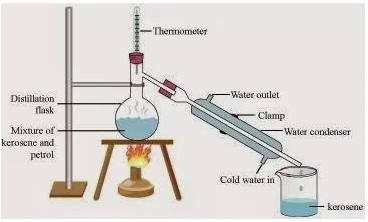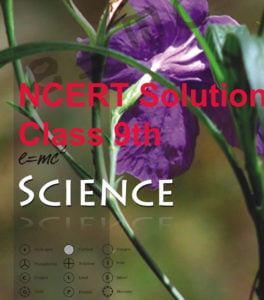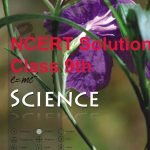NCERT Solution Class 9th Science Chapter 2: Is Matter Around Us Pure, NCERT Solutions for Class 9 Science (Chemistry) Chapter 2 – Is Matter Around Us Pure solved by Expert Teachers as per NCERT (CBSE) Book guidelines. These solutions are part of NCERT Solutions for Class 9 Science. Here we have given Class 9 NCERT Science Textbook Solutions for Chapter 2 Is Matter Around Us Pure.
NCERT Solution Class 9th Science
Chapter 2: Is Matter Around Us Pure
- NCERT Solution Class 9th Science
- Chapter 2: Is Matter Around Us Pure
- 1: What is meant by a pure substance?
- 2: List the points of differences between homogeneous and heterogeneous mixtures.
- 1: Differentiate between homogeneous and heterogeneous mixtures with examples.
- 2: How are sol, solution and suspension different from each other?
- 3:To make a saturated solution, 36 g of sodium chloride is dissolved in 100 g ofwater at 293 K. Finds its concentration at this temperature.
- Class 9th Science Chapter 2 Short Type Question Answer
- Class 9th Science Chapter 2
- Exercises
- 1: Which separation techniques will apply for the separation of the following?
- 2: Write the steps you would use for making tea. Use the words – solution, solvent, solute, dissolve, soluble, insoluble, filtrate and residue.
- 3:Pragya tested the solubility of three different substances at different temperatures and collected the data as given below (results are given in the following table, as grams of substance dissolved in 100 grams of water to form a saturated solution).
- 4: Explain the following giving examples.
- NCERT Solution Class 9th Science Chapter 2: Is Matter Around Us Pure
- Chapter 2: Is Matter Around Us Pure
1: What is meant by a pure substance?
Answer: A pure substance is the one that consists of a single type of particles, i.e., all constituent particles of the substance have the same chemical nature. Pure substances can be classified as elements or compounds.
2: List the points of differences between homogeneous and heterogeneous mixtures.
Answer: A homogeneous mixture is a mixture having a uniform composition throughout the mixture. For example salt in water, sugar in water, copper sulfate in water.
A heterogeneous mixture is a mixture having a non-uniform composition throughout the mixture. For example sodium chloride and iron filings, salt, sulfur, oil, and water.
1: Differentiate between homogeneous and heterogeneous mixtures with examples.
Answer: A homogeneous mixture is a mixture having a uniform composition throughout the mixture. For example, mixtures of salt in water, sugar in water, copper sulfate in water, iodine in alcohol, alloy, and air have uniform compositions throughout the mixtures.
On the other hand, a heterogeneous mixture is a mixture having a non-uniform composition throughout the mixture. For example, composition of mixtures of sodium chloride and iron fillings, salt and sulphur, oil and water, chalk powder in water, wheat flour in water, milk and water are not uniform throughout the mixtures.
2: How are sol, solution and suspension different from each other?
Answer: Sol is a heterogeneous mixture. In this mixture, the solute particles are so small that they cannot be seen with the naked eye. Also, they seem to be spread uniformly throughout the mixture. The Tyndall effect is observed in this mixture.
For example milk of magnesia, mud
Solution is a homogeneous mixture. In this mixture, the solute particles dissolve and spread uniformly throughout the mixture. The Tyndall effect is not observed in this mixture.
For example: salt in water, sugar in water, iodine in alcohol, alloy
Suspensions are heterogeneous mixtures. In this mixture, the solute particles are visible to the naked eye, and remain suspended throughout the bulk of the medium. The Tyndall effect is observed in this mixture.
For example: chalk powder and water, wheat flour and water.
3:To make a saturated solution, 36 g of sodium chloride is dissolved in 100 g of
water at 293 K. Finds its concentration at this temperature.
Answer: Mass of solute (sodium chloride) = 36 g (Given)
Mass of solvent (water) = 100 g (Given)
Then, mass of solution = Mass of solute + Mass of solvent
= (36 + 100) g
= 136 g
Therefore, concentration (mass by mass percentage) of the solution
=Mass of soluteMass of solventX100%=36136X100%=26.4%
Class 9th Science Chapter 2 Short Type Question Answer
See Also: NCERT Solutions for Class 9th: Ch 2 Is Matter Around Us Pure
1: How will you separate a mixture containing kerosene and petrol (difference in their boiling points is more than 25°C), which are miscible with each other?
Answer: A mixture of two miscible liquids having a difference in their boiling points more than 25°C can be separated by the method of distillation. Thus, kerosene and petrol can be separated by distillation

In this method, the mixture of kerosene and petrol is taken in a distillation flask with a thermometer fitted in it. We also need a beaker, a water condenser, and a Bunsen burner. The apparatus is arranged as shown in the above figure. Then, the mixture is heated slowly. The thermometer should be watched simultaneously.
Kerosene will vaporize and condense in the water condenser. The condensed
kerosene is collected from the condenser outlet, whereas petrol is left behind in the distillation flask.
2: Name the technique to separate
(i) butter from curd
Answer: Butter can be separated from curd by centrifugation.
(ii) salt from sea-water
Answer: Salt can be separated from sea-water by evaporation.
(iii) camphor from salt.
Answer: Camphor can be separated from salt by sublimation.
3: What type of mixtures is separated by the technique of crystallization?
Answer: By the technique of crystallization, pure solids are separated from impurities. For example, salt obtained from the sea is separated from impurities; crystals of alum (Phitkari) are separated from impure samples.
Class 9th Science Chapter 2
See Also: NCERT Solutions for Class 9 Science Chapter 2 – Is Matter A
- 1: Classify the following as chemical or physical changes:
• cutting of trees,
• melting of butter in a pan,
• rusting of almirah,
• boiling of water to form steam,
• passing of electric current, through water and the water breaking down into hydrogen and oxygen gases,
• dissolving common salt in water,
• making a fruit salad with raw fruits, and
• burning of paper and wood.
Answer: - Cutting of trees → Physical change
- Melting of butter in a pan → Physical change
- Rusting of almirah → Chemical chang
- Boiling of water to form steam → Physical change
- Passing of electric current through water, and water breaking down into
hydrogen and oxygen gas → Chemical change - Dissolving common salt in water → Physical change
- Making a fruit salad with raw fruits → Physical change
- Burning of paper and wood → Chemical change
2: Try segregating the things around you as pure substances or mixtures.
Answer: Pure substance: Water, salt, sugar etc.
Mixture: Salt water, soil, wood, air, cold drink, rubber, sponge, fog, milk, butter, clothes, food.
Exercises
1: Which separation techniques will apply for the separation of the following?
(a) Sodium chloride from its solution in water.
Answer: Crystallization or Evaporation.
(b) Ammonium Chloride from a mixture containing Sodium Chloride and
Ammonium Chloride.
Answer: Sublimation.
(c) Small pieces of metal in the engine oil of a car.
Answer: Centrifugation or Sedimentation.
(d) Different pigments from an extract of flower petals.
Answer: Chromatography.
(e) Butter from curd.
Answer: Centrifugation.
(f) Oil from water.
Answer: Separating funnel.
(g) Tea leaves from tea.
Answer: Hand-picking.
(h) Iron pins from sand.
Answer: Magnetic separation.
(i) Wheat grains from husk.
Answer: Winnowing.
(j) Fine mud particles suspended in water.
Answer: Centrifugation.
NCERT Solution Class 9th Science Chapter 2: Is Matter Around Us Pure
See Also: Science- Class 9th NCERT Solutions
2: Write the steps you would use for making tea. Use the words – solution, solvent, solute, dissolve, soluble, insoluble, filtrate and residue.
Answer: Take the solvent, water, in a kettle. Heat it. When the solvent boils, add the solute, milk. Milk and water form a solution. Then pour some tea leaves over a sieve. Pour a slowly hot solution of milk over tea leaves. The Colour of tea leaves goes into solution as filtrate. The remaining tea leaves being insoluble remains as a residue. Add requisite sugar which dissolves and the tea is ready.
3:Pragya tested the solubility of three different substances at different temperatures and collected the data as given below (results are given in the following table, as grams of substance dissolved in 100 grams of water to form a saturated solution).
(a)What mass of potassium nitrate would be needed to produce a saturated
solution of potassium nitrate in 50 grams of water at 313 K?
Answer: At 313 K,
Potassium nitrate for saturated solution of 100 grams of water = 62 g
∴ Potassium nitrate for saturated solution of 50 grams of water = 31 g.
(b)Pragya makes a saturated solution of potassium chloride in water at 353 K
and leaves the solution to cool at room temperature. What would she
observe as the solution cools? Explain.
Answer: Some amount of dissolved Potassium Chloride will reappear as
undissolved solid as solubility of solute decreases with the decrease of
temperature.
(c) Find the solubility of each salt at 293 K. Which salt has the highest
solubility at this temperature?
Answer: Solubility of each salt at 393 K are as follows:
- Potassium nitrate 32
- Sodium chloride 36
- Potassium chloride 35
- Ammonium chloride 37
- Ammonium chloride salt has the highest solubility at this temperature.
(d)What is the effect of change of temperature on the solubility of a salt?
Answer: Solubility of salt increases with the increase in temperature.
4: Explain the following giving examples.
(a) Saturated solution,
Answer: Saturated Solution: A solution in which no more of the solid (solute) can be dissolved at a given temperature is called a saturated solution. Suppose 50 gm of a solute is the maximum amount that can be dissolved in 100 gm water at 298 K. Then 150 gm of the solution so obtained is the saturated solution at 298 K.
(b)Pure substance,
Answer: Pure Substance: A pure substance consists of a single of matter or particles and cannot be separated into other kind of matter by any physical process.
Pure substances always have the same colour, taste and texture at a giventemperature and pressure. For example, pure water is always colourless,odorless and tasteless and boils at 373 K at normal atmospheric pressure.
(c) Colloid,
Answer: Colloid: Colloids are heterogeneous mixtures the particle size is too small to be seen with a naked eye, but it is big enough to scatter light. The
particles are called the dispersed phase and the medium in which they are
distributed is called the dispersion medium. Colloids are useful in industry
and daily life. A colloid has the following characteristics:
- It is a heterogeneous mixture.
- The size of particles of a colloid lies between 1 – 100 nm and cannot
be seen by naked eyes. - The particles of colloid can scatter a beam of light passing through
it and make the path visible. - The particles of colloid cannot be separated from the mixture by
filtration. The process of separation of colloidal particles is known
as ‘centrifugation’. - They do not settle down when left undisturbed. In other words
colloids are quite stable e.g. smoke, milk, fog, cloud etc.
NCERT Solution Class 9th Science Chapter 2: Is Matter Around Us Pure
See Also: NCERT Solutions for Class 9 Science
(d)Suspension.
Answer: Suspension: A ‘suspension’ is a heterogeneous mixture in which the solute particles do not dissolve but remain suspended throughout the bulk of the medium. A suspension has the following characteristics:
- It is a heterogeneous mixture.
- The size of particles of a suspension is greater than 100 nm and is
visible to naked eyes. - The particles of suspension can scatter a beam of light passing
through it. - The particles of a suspension settle down when left undisturbed.
- The particles of a suspension can be separated from its mixture by
filtration.
5: Classify each of the following as a homogeneous or heterogeneous mixture: soda water, wood, air, soil, vinegar, filtrated tea.
Answer: Homogeneous mixture – soda water, air, vinegar, filtered tea.
Heterogeneous mixture – wood, soil.
6: How would you confirm that a colourless liquid given to you is pure water?If
Answer: Every liquid has a characteristic boiling point at 1 atmospheric pressure. If the given colourless liquid boils exactly at 373 K at 1 atmospheric pressure, then it is pure water. If the boiling point is different, then the water is contaminated.
7: Which of the following materials fall in the category of a ‘pure substance’?
(a)Ice
(b)Milk
(c) Iron
(d)Hydrochloric acid
(e) Calcium oxide
(f) Mercury
(g) Brick
(h)Wood
(i) Air.
Answer:
(a), (c), (d), (e) and (f) are pure substances.
8: Identify the solutions among the following mixtures.
(a)Soil
(b)Sea water
(c)Air
(d)Coal
(e) Soda water.
Answer:
Solutions among the following mixtures.
(b) Sea water
(c) Air
(e) Soda water.
9: Which of the following will show “Tyndall effect”?
(a)Salt solution
(b)Milk
(c) Copper sulphate solution
(d)Starch solution.
Answer: (b) and (d) are colloids and will show Tyndall Effect.
10: Classify the following into elements, compounds and mixtures.
(a) Sodium
(b) Soil
(c) Sugar solution
(d) Silver
(e) Calcium carbonate
(f) Tin
(g) Silicon
(h) Coal
(i) Air
(j) Soap
(k) Methane
(l) Carbon dioxide
(m) Blood
Answer: Elements – sodium, silver, tin, silicon.
Compounds – calcium carbonate, methane, carbon dioxide.
Mixtures – soil, sugar solution, coal, air, soap, blood.
11: Which of the following are chemical changes?
(a)Growth of a plant
(b)Rusting of iron
(c) Mixing of iron filings and sand
(d)Cooking of food
(e)Digestion of food
(f) Freezing of water
(g)Burning of a candle.
Answer: Following are Chemical changes.
(a)Growth of a plant
(b)Rusting of iron
(c) Cooking of food
(d)Digestion of food
(e) Burning of a candle.
[table id=1 /]

Hi, I’m Dev Kirtonia, Founder & CEO of Dev Library. A website that provides all SCERT, NCERT 3 to 12, and BA, B.com, B.Sc, and Computer Science with Post Graduate Notes & Suggestions, Novel, eBooks, Biography, Quotes, Study Materials, and more.





